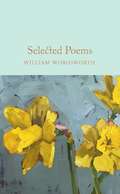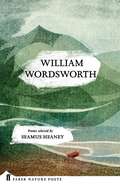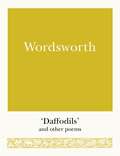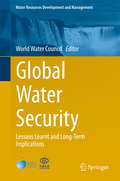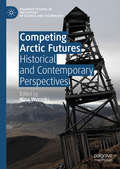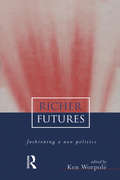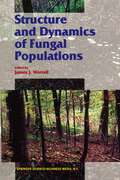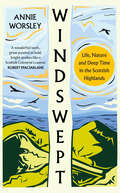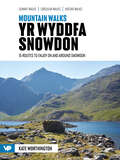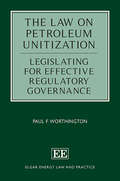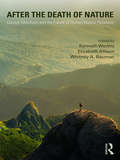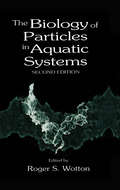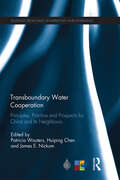- Table View
- List View
Effective Writing Strategies for Engineers and Scientists
by Donald C. WoolstonThis easy-to-read, concise book is filled with examples, hints, reminders and reviews designed to help engineers and scientists develop effective writing skills. Use the book to learn to write better reports, memos, and journal articles and keep it close at hand when you have questions about organization, clarity and style, writing and revising rough drafts, graphics, workplace writing, computers in writing, and legal issues in writing. The book also contains four helpful appendices on common errors, equations and abbreviations, preparing manuscripts for publication, and documenting information sources. Effective Writing Strategies for Engineers and Scientists provides easy training for the type of writing required of engineers and scientists, gives specific advise for conveying complicated information, and describes how to synthesize information according to specific writing strategies. It is a "must" for every scientist's and engineer's bookshelf.
Connectivity Conservation Management: A Global Guide
by Graeme L. Worboys Wendy L. Francis Michael LockwoodIn an era of climate change, deforestation and massive habitat loss, we can no longer rely on parks and protected areas as isolated 'islands of wilderness' to conserve and protect vital biodiversity. Increasing connections are being considered and made between protected areas and 'connectivity' thinking has started to expand to the regional and even the continental scale to match the challenges of conserving biodiversity in the face of global environmental change. This groundbreaking book is the first guide to connectivity conservation management at local, regional and continental scales. Written by leading conservation and protected area management specialists under the auspices of the World Commission on Protected Areas of IUCN, the International Union for the Conservation of Nature, this guide brings together a decade and a half of practice and covers all aspects of connectivity planning and management The book establishes a context for managing connectivity conservation and identifies large scale naturally interconnected areas as critical strategic and adaptive responses to climate change. The second section presents 25 rich and varied case studies from six of the eight biogeographic realms of Earth, including the Cape Floristic Region of Africa, the Maloti-Drakensberg Mountains, the Australian Alps to Atherton Corridor, and the Sacred Himalayan Landscape connectivity area (featuring Mount Everest.) The remarkable 3200 kilometre long Yellowstone to Yukon corridor of Canada and the United States of America is described in detail. The third section introduces a model for managing connectivity areas, shaped by input from IUCN workshops held in 2006 and 2008 and additional research. The final chapter identifies broad guidelines that need to be considered in undertaking connectivity conservation management prior to reinforcing the importance and urgency of this work. This handbook is a must have for all professionals in protected area management, conservation, land management and resource management from the field through senior management and policy. It is also an ideal reference for students and academics in geography, protected area management and from across the environmental and natural sciences, social sciences and landuse planning. Published with Wilburforce Foundation, WWF, ICIMOD, IUCN, WCPA, Australian Alps and The Nature Conservancy.
Connectivity Conservation Management: A Global Guide
by Graeme L. Worboys Wendy L. Francis Michael LockwoodIn an era of climate change, deforestation and massive habitat loss, we can no longer rely on parks and protected areas as isolated 'islands of wilderness' to conserve and protect vital biodiversity. Increasing connections are being considered and made between protected areas and 'connectivity' thinking has started to expand to the regional and even the continental scale to match the challenges of conserving biodiversity in the face of global environmental change. This groundbreaking book is the first guide to connectivity conservation management at local, regional and continental scales. Written by leading conservation and protected area management specialists under the auspices of the World Commission on Protected Areas of IUCN, the International Union for the Conservation of Nature, this guide brings together a decade and a half of practice and covers all aspects of connectivity planning and management The book establishes a context for managing connectivity conservation and identifies large scale naturally interconnected areas as critical strategic and adaptive responses to climate change. The second section presents 25 rich and varied case studies from six of the eight biogeographic realms of Earth, including the Cape Floristic Region of Africa, the Maloti-Drakensberg Mountains, the Australian Alps to Atherton Corridor, and the Sacred Himalayan Landscape connectivity area (featuring Mount Everest.) The remarkable 3200 kilometre long Yellowstone to Yukon corridor of Canada and the United States of America is described in detail. The third section introduces a model for managing connectivity areas, shaped by input from IUCN workshops held in 2006 and 2008 and additional research. The final chapter identifies broad guidelines that need to be considered in undertaking connectivity conservation management prior to reinforcing the importance and urgency of this work. This handbook is a must have for all professionals in protected area management, conservation, land management and resource management from the field through senior management and policy. It is also an ideal reference for students and academics in geography, protected area management and from across the environmental and natural sciences, social sciences and landuse planning. Published with Wilburforce Foundation, WWF, ICIMOD, IUCN, WCPA, Australian Alps and The Nature Conservancy.
Selected Poems: Selected Poems (Macmillan Collector's Library)
by William WordsworthA pioneer of the Romantic movement, William Wordsworth wrote about the natural world and human emotion with a clarity of language which revolutionized poetry. Part of the Macmillan Collector’s Library; a series of stunning, clothbound, pocket-sized classics with gold foiled edges and ribbon markers. These beautiful books make perfect gifts or a treat for any book lover. This edition has an introduction by Peter Harness.Selected Poems brings together some of Wordsworth’s most acclaimed and influential works, including an extract from his magnus opus, The Prelude, alongside shorter poems such as ‘I Wandered Lonely as a Cloud’, ‘To a Skylark’ and ‘Tintern Abbey’. Wordsworth’s poems, often written at his home in Grasmere in the beautiful English Lake District, are lyrical evocations of nature and of spirituality. They have a force and clarity of language akin to everyday speech which was truly groundbreaking.
William Wordsworth
by William WordsworthIn this series, a contemporary poet selects and introduces a poet of the past. By their choice of poems and by the personal and critical reactions they express in their prefaces, the editors offer insights into their own work as well as providing an accessible and passionate introduction to the most important poets in our literature.Earth has not anything to show more fair:Dull would he be of soul who could pass by A sight so touching in its majesty . . .-- Composed Upon Westminster Bridge,September 3, 1802
Wordsworth: 'Daffodils' and Other Poems (Pocket Poets #4)
by William WordsworthWilliam Wordsworth is chiefly remembered as one of the ‘Lake Poets’. Yet he was also one of the founders of English Romanticism, a writer whose early revolutionary fervor imbued his verse and his ideals.Much of Wordsworth’s work was inspired by nature, but to a style rich in lyrical imagery he brought a deep interest in liberal humanitarianism and a profound concern for the lives, habits and speech of ordinary people, especially country people.This pocket-sized collection includes: ‘I wandered lonely as a cloud’ (‘Daffodils’), ‘Ode. Intimations of Immortality’, ‘Character of the Happy Warrior’, ‘The Solitary Reaper’, ‘To a Sky-Lark’, ‘Tintern Abbey’, and extracts from ‘The Prelude’.
Global Biodiversity: Status of the Earth’s Living Resources
by World Conservation Monitoring CentreGlobal Biodiversity is the most comprehensive compendium of conservation information ever published. It provides the first systematic report on the status, distribution, management, and utilisation of the planet's biological wealth.
Global Water Security: Lessons Learnt and Long-Term Implications (Water Resources Development and Management)
by World Water CouncilThis book highlights the relationship between the water sector and various other sectors in order to establish an improved understanding of the importance of water resources as an essential cross-cutting vector of socio-economic development. The book is both policy and practice oriented and is not constrained by existing definitions on water security. It includes actual experiences of policy, management, development and governance decisions taken within the water sector, and examples on how these have affected the energy and agricultural sectors as well as impacted the environment, and vice versa, as appropriate. It also discusses trade-offs, short and long-term implications, lessons learnt, and the way forward. The book includes case studies on cities, countries and regions such as Australia, China, Singapore, Central Asia, Morocco, Southern Africa, France, Latin America, Brazil and California.
EarthEd: Rethinking Education on a Changing Planet (State of the World)
by Worldwatch InstituteIn the latest installment of State of the World, a diverse group of education experts share innovative approaches to teaching and learning in a new era. Topics include systems thinking for kids; the importance of play in early education; social emotional learning; comprehensive sexuality education; indigenous knowledge; sustainable business; medical training to treat the whole person; teaching law in the Anthropocene; and more.
Competing Arctic Futures: Historical and Contemporary Perspectives (Palgrave Studies in the History of Science and Technology)
by Nina WormbsThis edited collection explores how narratives about the future of the Arctic have been produced historically up until the present day. The contemporary deterministic and monolithic narrative is shown to be only one of several possible ways forward. This book problematizes the dominant prediction that there will be increased shipping and resource extraction as the ice melts and shows how this seemingly inevitable future has consequences for the action that can be taken in the present. This collection looks to historical projections about the future of the Arctic, evaluating why some voices have been heard and championed, while others remain marginalised. It questions how these historical perspectives have shaped resource allocation and governance structures to understand the forces behind change in the Arctic region. Considering the history of individuals and institutions, their political and economic networks and their perceived power, the essays in this collection offer new perspectives on how the future of the Arctic has been produced and communicated.
Competing Arctic Futures: Historical and Contemporary Perspectives (Palgrave Studies in the History of Science and Technology)
by Nina WormbsThis edited collection explores how narratives about the future of the Arctic have been produced historically up until the present day. The contemporary deterministic and monolithic narrative is shown to be only one of several possible ways forward. This book problematizes the dominant prediction that there will be increased shipping and resource extraction as the ice melts and shows how this seemingly inevitable future has consequences for the action that can be taken in the present. This collection looks to historical projections about the future of the Arctic, evaluating why some voices have been heard and championed, while others remain marginalised. It questions how these historical perspectives have shaped resource allocation and governance structures to understand the forces behind change in the Arctic region. Considering the history of individuals and institutions, their political and economic networks and their perceived power, the essays in this collection offer new perspectives on how the future of the Arctic has been produced and communicated.
Richer Futures: Fashioning a new politics (Earthscan Library Collection: Environmental And Resource Economics Set Ser.)
by Ken WorpoleIn every area of life, traditional, centralized party politics has been failing and the seeds of a new form of political life are being sown. This is true in housing, health, education, consumption and transport, where public policy is attracting increasing criticism. In an age of social alienation and urban despondency Richer Futures is a timely response to the growing interest in community-based, self-help action. It introduces new forms of communication and decision-making and sets out a programme for a sustainable politics.Contributions from some of the best-known thinkers and writers on contemporary urban, cultural and social policy (and campaigns) in Britain today pay tribute to the ideas and industrious activities of the influential writer and commentator Colin Ward. This uplifting collection of essays looks forward to a new politics of self-management and environmentally aware and sustainable lifestyles.Ken Worpole has written a number of books on urban and cultural policy, and a series of influential reports for Comedia, Demos and the Department of the Environment.Originally published in 1999
Structure and Dynamics of Fungal Populations (Population and Community Biology Series #25)
by J. WorrallFungi are among the most versatile and diverse groups of organisms in their morphology, life cycles, and ecology. This has provided endless fasci nation and intrigue to those who have studied fungi, but it has also made it difficult to understand fungal biology from the perspective of the broader fields of evolution, ecology, genetics, and population biology. That is changing. Details of fungal biology have been elucidated at an exciting pace, increasingly allowing us to understand fungi on the bases of general biological principles. Moreover, many who study fungi have lately emulated some of the great mycologists and plant pathologists of the early years in applying an insight born of broad perspective. This change has been particularly apparent in fungal population biology. In this book, many of those at the forefront of that change summarize, integrate and comment on recent developments and ideas on populations of fungi. By taking a broad perspective, they show how new information on fungi may contribute to concepts and ideas of biology as a whole. Just as important, they contribute to further invigoration of fungal population research by illuminating mycology with new ideas and concepts, derived in part from other biological fields.
Windswept: Life, Nature And Deep Time In The Scottish Highlands
by Annie Worsley‘Windswept is a wonderful work, prose painted in bold, bright strokes like a Scottish Colourist's canvas’ ROBERT MACFARLANE ‘I have read pages and pages of this wonderful book, swept away by its beauty and understanding, its chromatic brilliance’ ADAM NICOLSON
The Ends Of The Earth: Perspectives On Modern Environmental History (Studies In Environment And History Ser. (PDF))
by Donald Worster Alfred W. CrosbySince 1492, when Columbus 'discovered' America, the world has been moving toward an increasingly integrated global economy, higher population levels and consequently greater resource demands, and an increasingly precarious state of the biosphere. These developments play a major part in both modern history and in daily life. Understanding their interrelationships and development is crucial to the future of humanity and of the Earth, and is the unifying theme of this collection of readings.
The Ends Of The Earth: Perspectives On Modern Environmental History (Studies In Environment And History Ser. (PDF))
by Donald Worster Alfred W. CrosbySince 1492, when Columbus 'discovered' America, the world has been moving toward an increasingly integrated global economy, higher population levels and consequently greater resource demands, and an increasingly precarious state of the biosphere. These developments play a major part in both modern history and in daily life. Understanding their interrelationships and development is crucial to the future of humanity and of the Earth, and is the unifying theme of this collection of readings.
Sustainable Solutions: Let Knowledge Serve the City
by B. D. Wortham-Galvin Jennifer H. Allen Jacob ShermanPortland, Oregon. Sustainability might not seem glamourous, but Portland is making a name for itself as one of the most sustainable cities in the world. Whether you’ve heard about the farmers’ markets, the cycle-friendly streets or the ongoing efforts to balance livability and equity, Portland is leading the way in urban sustainability: this book helps us understand how it achieves this.A critical component of Portland’s success is collaboration between different communities and institutions; the Sustainable Solutions series examines higher education’s role in these partnerships. In exploring how best to “let knowledge serve the city”, Portland State University translates its founding motto from mere words to applied research and action.This first volume examines different approaches to collaborative work that PSU has taken, both within the university and with community partners: how have barriers been overcome between different areas of study, between academia and the public, and why is bridging these divides so important? It also introduces the themes of the engaged university, social justice, climate change and sustainable economic development, which shape PSU’s work.Let Knowledge Serve the City is ideal for anyone seeking best practice in connecting students and universities with the needs of local communities. From public interest design and student leadership, to food justice and age-friendly development, authors combine academically rigorous theories of sustainability and community-university partnerships with lessons learned on how to realize ideals of sustainable development.
Mountain Walks Yr Wyddfa/Snowdon: 15 routes to enjoy on and around Snowdon (Mountain Walks)
by Kate WorthingtonMountain Walks Yr Wyddfa/Snowdon by Kate Worthington is a guide to walking routes to the summit of Yr Wyddfa in Eryri (Snowdonia). Alongside the summit routes, there are also lower-level alternatives for mixed weather or shorter days and those new to mountain walking. Among the 15 inspiring routes, the classics are all included, such as the Yr Wyddfa/Snowdon Horseshoe via the grade-1 scramble of Crib Goch, and even those who are familiar with the area will find new and imaginative route ideas to discover. Whether you aspire to climb Yr Wyddfa on a straightforward route, or you're looking for a bigger adventure, this is the only guidebook you need. Together with stunning photography, each route features: Ordnance Survey 1:25,000 maps; easy-to-follow, detailed directions; essential info about public transport and safety advice; details about the terrain and navigation; facilities, refreshments and points of interest; and downloadable GPX files.
The Law on Petroleum Unitization: Legislating for Effective Regulatory Governance (Elgar Energy Law and Practice series)
by Paul F. WorthingtonThis comprehensive book addresses both the principles and the practicalities of petroleum unitization by mapping out the evolution of and rationale for unitization in legislation and by providing much-needed guidance on the formulation of a legislative framework for effective regulatory governance of the unitization process. Drawing on his own extensive experience of the global petroleum industry and his insights into petroleum unitization in some 90 jurisdictions worldwide, Paul F. Worthington discusses the key elements of legislation for incorporation into petroleum unitization statutes, implementing regulations and production contracts. He provides a basis for legal drafting at all levels of this tripartite legislative framework as well as guidelines for compliance with good international petroleum practice. The Law on Petroleum Unitization: Legislating for Effective Regulatory Governance will prove essential reading for legal practitioners working in government ministries with a responsibility for energy affairs as well as for energy regulators, energy companies and those legal firms who provide unitization advice. Petroleum consultancies, negotiators and energy policy advisers within professional bodies and academia will also benefit from this book’s thorough and incisive treatment of the subject matter.
After the Death of Nature: Carolyn Merchant and the Future of Human-Nature Relations
by Kenneth Worthy Elizabeth Allison Whitney A. BaumanCarolyn Merchant’s foundational 1980 book The Death of Nature: Women, Ecology, and the Scientific Revolution established her as a pioneering researcher of human-nature relations. Her subsequent groundbreaking writing in a dozen books and over one hundred peer-reviewed articles have only fortified her position as one of the most influential scholars of the environment. This book examines and builds upon her decades-long legacy of innovative environmental thought and her critical responses to modern mechanistic and patriarchal conceptions of nature and women as well as her systematic taxonomies of environmental thought and action. Seventeen scholars and activists assess, praise, criticize, and extend Merchant’s work to arrive at a better and more complete understanding of the human place in nature today and the potential for healthier and more just relations with nature and among people in the future. Their contributions offer personal observations of Merchant’s influence on the teaching, research, and careers of other environmentalists.
After the Death of Nature: Carolyn Merchant and the Future of Human-Nature Relations
by Kenneth Worthy Elizabeth Allison Whitney A. BaumanCarolyn Merchant’s foundational 1980 book The Death of Nature: Women, Ecology, and the Scientific Revolution established her as a pioneering researcher of human-nature relations. Her subsequent groundbreaking writing in a dozen books and over one hundred peer-reviewed articles have only fortified her position as one of the most influential scholars of the environment. This book examines and builds upon her decades-long legacy of innovative environmental thought and her critical responses to modern mechanistic and patriarchal conceptions of nature and women as well as her systematic taxonomies of environmental thought and action. Seventeen scholars and activists assess, praise, criticize, and extend Merchant’s work to arrive at a better and more complete understanding of the human place in nature today and the potential for healthier and more just relations with nature and among people in the future. Their contributions offer personal observations of Merchant’s influence on the teaching, research, and careers of other environmentalists.
The Biology of Particles in Aquatic Systems, Second Edition
by Roger S. WottonThe Biology of Particles in Aquatic Systems, Second Edition presents the latest information on particulate and dissolved matter found in aquatic habitats ranging from small streams to oceans. Only by studying this matter can we gain an understanding of the functioning of aquatic ecosystems and thus be able to predict changes that may occur as these systems become stressed. Updated and extensively revised, this new edition covers such topics as classification of particulate and dissolved matter, origin and formation of particles aquatic systems, factors affecting particle aggregation, methods for capturing particles by benthic and planktonic animals, and the use of particulate and dissolved organic matter as food.
The Biology of Particles in Aquatic Systems, Second Edition
by Roger S. WottonThe Biology of Particles in Aquatic Systems, Second Edition presents the latest information on particulate and dissolved matter found in aquatic habitats ranging from small streams to oceans. Only by studying this matter can we gain an understanding of the functioning of aquatic ecosystems and thus be able to predict changes that may occur as these systems become stressed. Updated and extensively revised, this new edition covers such topics as classification of particulate and dissolved matter, origin and formation of particles aquatic systems, factors affecting particle aggregation, methods for capturing particles by benthic and planktonic animals, and the use of particulate and dissolved organic matter as food.
Transboundary Water Cooperation: Principles, Practice and Prospects for China and Its Neighbours (Routledge Special Issues on Water Policy and Governance)
by Patricia Wouters Huiping Chen James E. NickumChina and its neighbours face a series of water security issues, in which international law plays a vital role. Paramount to both policymakers and researchers in the field of water law, the current status of transboundary water cooperation schemes and how these operate in China is of global significance. Grounded in international experience, this comprehensive volume provides readers with an up-to-date overview of current international transboundary water resource sharing policies and practices, including detailed case studies at both domestic and international levels. The authors discuss existing international laws, treaties, and principles that may stimulate transboundary water cooperation and dialogue, and then analyse a number of international experiences with treaties in North America, Eastern Europe, and Central Asia. They take stock of China’s water resource issues, legal practices and options, examine case studies of China’s southern shared rivers, and explore some innovative approaches to cooperative management of shared waters within China. The articles in this book were originally published in the journal Water International.
Transboundary Water Cooperation: Principles, Practice and Prospects for China and Its Neighbours (Routledge Special Issues on Water Policy and Governance)
by Patricia Wouters Huiping Chen James E. NickumChina and its neighbours face a series of water security issues, in which international law plays a vital role. Paramount to both policymakers and researchers in the field of water law, the current status of transboundary water cooperation schemes and how these operate in China is of global significance. Grounded in international experience, this comprehensive volume provides readers with an up-to-date overview of current international transboundary water resource sharing policies and practices, including detailed case studies at both domestic and international levels. The authors discuss existing international laws, treaties, and principles that may stimulate transboundary water cooperation and dialogue, and then analyse a number of international experiences with treaties in North America, Eastern Europe, and Central Asia. They take stock of China’s water resource issues, legal practices and options, examine case studies of China’s southern shared rivers, and explore some innovative approaches to cooperative management of shared waters within China. The articles in this book were originally published in the journal Water International.


